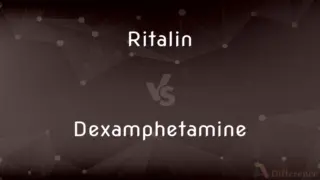Omentum vs. Mesentery — What's the Difference?
Edited by Tayyaba Rehman — By Fiza Rafique — Updated on September 28, 2023
Omentum is a fatty apron-like tissue that covers the intestines and organs, while Mesentery connects the intestines to the abdominal wall. Both are peritoneal structures.

Difference Between Omentum and Mesentery
Table of Contents
ADVERTISEMENT
Key Differences
Both the Omentum and Mesentery are integral parts of the abdominal cavity and play distinct roles in supporting the organs within. They are derived from the peritoneum, which lines the abdominal and pelvic cavities.
The Omentum, specifically the greater omentum, drapes like an apron from the stomach, covering the intestines and other abdominal organs. It is a fatty, double-layered fold that can act as an insulator and a protector against infections. On the other hand, the Mesentery provides a connection for the intestines to the posterior abdominal wall, ensuring that they stay in place.
Structurally, the Omentum contains a significant amount of fat, making it yellowish, whereas the Mesentery is thinner and more membranous. While the Mesentery is essential for vascular supply and lymphatic drainage of the intestines, the Omentum can move around the abdominal cavity and wall off infections.
Diseases and conditions can affect both the Omentum and Mesentery. For instance, tumors can grow on the Omentum, while the Mesentery can become inflamed in conditions like mesenteric ischemia.
Surgical procedures involving the abdominal cavity often require the manipulation or even removal of parts of the Omentum or Mesentery. Their roles in immune responses, healing, and other physiological functions are still being researched.
ADVERTISEMENT
Comparison Chart
Function
Insulates and protects organs
Anchors intestines to the abdominal wall
Structure
Fatty, apron-like
Thin, membranous
Relation to Organs
Drapes over intestines and organs
Directly connects intestines
Disease Association
Can have tumors
Can become inflamed (e.g., mesenteric ischemia)
Surgical Involvement
Can be partially removed during procedures
Essential for vascular supply to intestines
Compare with Definitions
Omentum
Drapes over the intestines and stomach.
The Omentum provides a protective layer for the abdominal organs.
Mesentery
A fold of tissue connecting intestines to the abdominal wall.
The Mesentery ensures the intestines stay in place.
Omentum
Acts as a barrier against infections.
The Omentum can move to wall off abdominal infections.
Mesentery
Thin and membranous structure.
Unlike the fatty Omentum, the Mesentery is more delicate.
Omentum
Contains fatty deposits.
The yellowish appearance of the Omentum is due to fat.
Mesentery
Provides vascular supply to the intestines.
Blood vessels run through the Mesentery to nourish the intestines.
Omentum
A fold of peritoneal tissue.
The surgeon examined the Omentum during the operation.
Mesentery
Can be affected by diseases like mesenteric ischemia.
Inflammation of the Mesentery can lead to severe pain.
Omentum
Can be involved in abdominal surgeries.
Part of the Omentum was removed due to a tumor.
Mesentery
Essential in certain surgical procedures.
During surgery, the Mesentery was carefully preserved.
Omentum
The greater omentum.
Mesentery
The mesentery is an organ that attaches the intestines to the posterior abdominal wall in humans and is formed by the double fold of peritoneum. It helps in storing fat and allowing blood vessels, lymphatics, and nerves to supply the intestines, among other functions.The mesocolon was thought to be a fragmented structure, with all named parts—the ascending, transverse, descending, and sigmoid mesocolons, the mesoappendix, and the mesorectum—separately terminating their insertion into the posterior abdominal wall.
Omentum
The lesser omentum.
Mesentery
Any of several folds of the peritoneum that connect the intestines to the dorsal abdominal wall, especially such a fold that envelops the jejunum and ileum.
Omentum
(anatomy) Either of two folds of the peritoneum that support the viscera.
Mesentery
(anatomy) The membrane that attaches the intestines to the wall of the abdomen, maintaining their position in the abdominal cavity, and supplying them with blood vessels, nerves, and lymphatics.
Omentum
A free fold of the peritoneum, or one serving to connect viscera, support blood vessels, etc.; an epiploön.
Mesentery
The membranes, or one of the membranes (consisting of a fold of the peritoneum and inclosed tissues), which connect the intestines and their appendages with the dorsal wall of the abdominal cavity. The mesentery proper is connected with the jejunum and ilium, the other mesenteries being called mesocæcum, mesocolon, mesorectum, etc.
Omentum
A fold of peritoneum supporting the viscera
Mesentery
One of the vertical muscular radiating partitions which divide the body cavity of Anthozoa into chambers.
Mesentery
A double layer of peritoneum that attaches to the back wall of the abdominal cavity and supports the small intestines
Common Curiosities
Which is fattier, the Omentum or the Mesentery?
The Omentum contains more fat.
How are the Omentum and Mesentery related to the peritoneum?
Both are derived from the peritoneum, which lines the abdominal cavity.
Why is the Mesentery vital for intestine health?
It provides vascular supply and lymphatic drainage.
How is the Omentum involved in immune responses?
It can move to areas of infection and wall them off.
Can the Omentum be entirely removed?
Parts can be removed, but it depends on the medical necessity.
How does the Mesentery support the intestines?
It anchors them to the abdominal wall.
Can the Omentum have medical issues?
Yes, tumors and cysts can form on the Omentum.
Are surgical procedures involving the Mesentery common?
Yes, especially in gastrointestinal surgeries.
What main function does the Omentum serve?
It acts as an insulator and protector for abdominal organs.
Is the Omentum always present in all individuals?
Yes, but its size and fat content can vary.
What happens if the Mesentery becomes inflamed?
Conditions like mesenteric ischemia can occur, causing pain.
Share Your Discovery

Previous Comparison
Kebab vs. Tikka
Next Comparison
Paperboard vs. CardboardAuthor Spotlight
Written by
Fiza RafiqueFiza Rafique is a skilled content writer at AskDifference.com, where she meticulously refines and enhances written pieces. Drawing from her vast editorial expertise, Fiza ensures clarity, accuracy, and precision in every article. Passionate about language, she continually seeks to elevate the quality of content for readers worldwide.
Edited by
Tayyaba RehmanTayyaba Rehman is a distinguished writer, currently serving as a primary contributor to askdifference.com. As a researcher in semantics and etymology, Tayyaba's passion for the complexity of languages and their distinctions has found a perfect home on the platform. Tayyaba delves into the intricacies of language, distinguishing between commonly confused words and phrases, thereby providing clarity for readers worldwide.











































